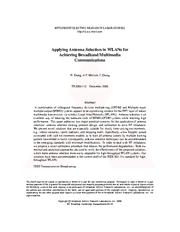Applying Antenna Selection in WLANs for Achieving Broadband Multimedia Communications
Hongyuan Zhang, Andreas F. Molisch, Jin Zhang
2006
IEEE transactions on broadcasting
A combination of orthogonal frequency division multiplexing (OFDM) and Multiple-inputmultiple-output (MIMO) systems appears to be a promising solution for the PHY layer of indoor multimedia transmission via wireless Local Area Networks (WLANs). Antenna selection is an excellent way of reducing the hardware costs of MIMO-OFDM systems while retaining high performance. This paper addresses two major practical concerns for the application of antenna selection: antenna selection training protocol
more »
... ign, and calibration to solve RF imbalance. We present novel solutions that are especially suitable for slowly time-varying environments, e.g., indoor scenarios, sports stadiums, and shopping malls. Specifically, a low Doppler spread associated with such environments enables us to train all antenna subsets by multiple training packets transmitted in burst; consequently antenna selection techniques can be accommodated in the emerging standards with minimum modifications. In order to deal with RF imbalance, we propose a novel calibration procedure that reduces the performance degradations. Both numerical and analytical approaches are used to verify the effectiveness of the proposed solutions, which make antenna selection more easily adaptable for high-throughput WLAN systems. Our solutions have been accommodated in the current draft of the IEEE 802.11n standard for highthroughput WLANs IEEE Transactions on Broadcasting This work may not be copied or reproduced in whole or in part for any commercial purpose. Permission to copy in whole or in part without payment of fee is granted for nonprofit educational and research purposes provided that all such whole or partial copies include the following: a notice that such copying is by permission of Mitsubishi Electric Research Laboratories, Inc.; an acknowledgment of the authors and individual contributions to the work; and all applicable portions of the copyright notice. Copying, reproduction, or republishing for any other purpose shall require a license with payment of fee to Mitsubishi Electric Research Laboratories, Inc. All rights reserved. Abstract-A combination of orthogonal frequency division multiplexing (OFDM) and Multiple-input-multiple-output (MIMO) systems appears to be a promising solution for the PHY layer of indoor multimedia transmission via wireless Local Area Networks (WLANs). Antenna selection is an excellent way of reducing the hardware costs of MIMO-OFDM systems while retaining high performance. This paper addresses two major practical concerns for the application of antenna selection: antenna selection training protocol design, and calibration to solve RF imbalance. We present novel solutions that are especially suitable for slowly time-varying environments, e.g., indoor scenarios, sports stadiums, and shopping malls. Specifically, a low Doppler spread associated with such environments enables us to train all antenna subsets by multiple training packets transmitted in burst; consequently antenna selection techniques can be accommodated in the emerging standards with minimum modifications. In order to deal with RF imbalance, we propose a novel calibration procedure that reduces the performance degradations. Both numerical and analytical approaches are used to verify the effectiveness of the proposed solutions, which make antenna selection more easily adaptable for high-throughput WLAN systems. Our solutions have been accommodated in the current draft of the IEEE 802.11n standard for high-throughput WLANs.
doi:10.1109/tbc.2006.884831
fatcat:j2ndouwuzbg6bl2dkgab772cji

